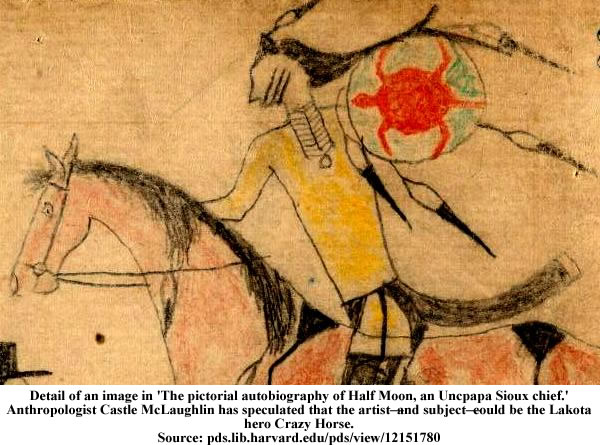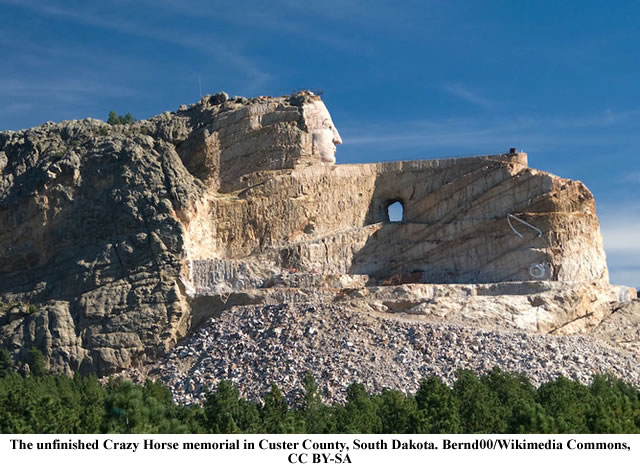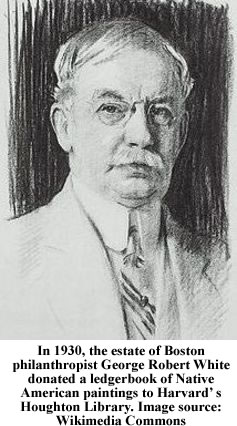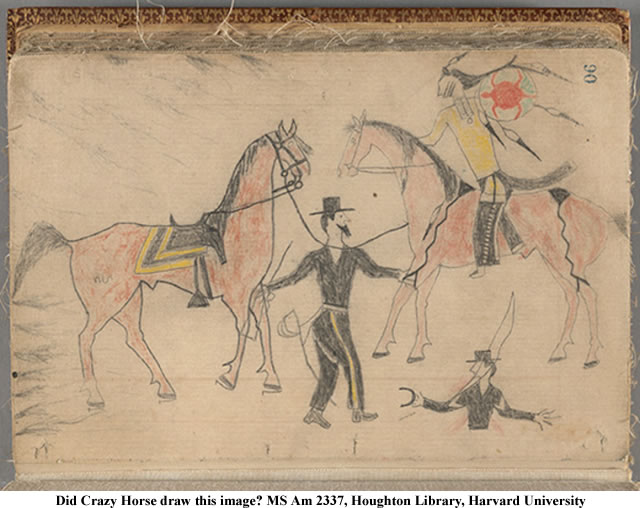 |
Canku Ota
|
 |
|
(Many Paths)
|
||
|
An Online Newsletter
Celebrating Native America
|
||
|
March 2015 - Volume
13 Number 3
|
||
|
|
||
|
Is This Drawing A
Self-Portrait Of Crazy Horse?
|
||
|
by Henry Adams - Ruth
Coulter Heede Professor of Art History at Case Western Reserve University
|
||
|
More than a century after he died, the Lakota warrior Crazy Horse, who famously fought Lieutenant Colonel Custer in the Battle of Little Bighorn, is thought of as transcendent force — attuned to the universe in a special way — though he's often commemorated in ways that are somewhat odd. He's the subject, for example, of a gargantuan (and controversial) mountain-top sculpture in South Dakota which — if ever finished — will be bigger than Mount Rushmore. And his name is the inspiration for a strip joint in Montmartre that has billed itself as "the most sophisticated cabaret in Paris."
It's easy to forget that Crazy Horse was once actually a real person, even if the historical record is often frustratingly incomplete. But Castle McLaughlin's latest publication brings readers into the world of the real Crazy Horse. Her book, titled A Lakota War Book from the Little Bighorn, also delves into one of the more intriguing art historical "Who-Done-Its" in recent memory. Drawings by Natives, for Natives
Ledgerbooks by Native Americans are relatively common, but most of them date from after the Indian Wars, when Native prisoners in Florida composed and sold them to tourists for much-needed cash. This book stands out because of its early (and quite specific) production date. As McLaughlin documents in detail, a US soldier discovered the book near the scaffold burial of an Indian Chief on the Little Bighorn battlefield, shortly after Custer's defeat. It was made not for tourists, but rather is an actual Native American "War Book," made by Native Americans, for Native Americans, and filled with drawings of war exploits. The 77 drawings in the book record warfare and horse stealing on the plains; 11 show the protagonist killing, wounding, or striking a US Soldier or civilian, often with uniforms or guns that are rendered so precisely that we can date the drawing to its conception. Most of the drawings are clearly autobiographical, showing diary-like depictions of day-to-day warrior life. For Native American warriors, such drawings recorded history. They acted as a means to boast about their battlefield accomplishments and to improve their status among fellow warriors. They also believed the images resulted in "good magic" for future conflicts. This specific book contains drawings that portray episodes from Red Cloud's War (1866-1868), during which Cheyenne and Lakota warriors — including Crazy Horse — defended the Yellowstone and Powder River Valleys. It was the only war ever "won" by western Native Americans, who forced the US military to retreat from the Bozeman trail. At first glance, the drawings may look childish. But as Picasso has pointed out, a drawing's intelligence isn't simply a matter of academic technique. Under McLaughlin's masterful guidance, we come to recognize that, in fact, the drawings in this book exhibit extraordinary intelligence of observation. Every detail is telling, whether it's a dragonfly painted on a shield or the way war paint was applied to the horses. As McLaughlin explains, these drawings are as rich and informative as any Euro-American literary text, although they speak in the language of images rather than letters, and shape reality within parameters set by a very different cultural framework. It's a remarkable lesson in the importance of examining something very closely, of learning to look at images in new ways. Who is artist D? Since no names accompany the drawings, McLaughlin designated each artist with a letter — A through F — and, through careful analysis, set out to discover who the artists might have been. Artist E, for example, drew himself connected to a bird in the sky with a wiggly line. He may well have been the warrior Thunderhawk, who, after the murder of Crazy Horse, returned the body to Crazy Horse's wife. Then there's artist B, who showed himself killing a bugler. This could be High Backbone, a friend of Crazy Horse's who appears to have killed a US Army bugler in the Fetterman fight. But the focus of McLaughlin's detective work is artist D, who, in one drawing, drew himself streaked with yellow body paint, and depicted his horse with lightning bolts lining its legs. It's just how Amos Bad Heart Bull – a nephew of Red Cloud – portrays Crazy Horse and his mare in a separate drawing of Crazy Horse in the Battle of the Little Bighorn. Could artist D be Crazy Horse? The episode shows the death of a US army officer and sergeant, which precisely corresponds with a December 1866 skirmish in which Crazy Horse killed Lieutenant Horatio S. Bingham and Sergeant Gideon R. Bowers.
There's also something about the drawings that fits with what we know of Crazy Horse: they seem to possess a peculiar and distinct energy. Even among his peers, Crazy Horse was known for possessing a mystical aura — a presence that set him apart from the others. As his cousin and contemporary Black Elk once explained:
Likewise the work of artist D differs from the other drawings. As McLaughlin notes: "His drawings testify that he is a deeply spiritual man whose success in war follows from his relationships with higher powers, especially the thunder beings … Artist D's dynamic, colorful, well-executed drawings … seem to express a contained inwardly focused energy that sets them apart from the rest of the images in the book." While the evidence is circumstantial, McLaughlin's patient accumulation of evidence is powerfully persuasive. By the time you reach the end of her account, it's hard to avoid the eerie feeling that you're in the presence of drawings by Crazy Horse himself. This article by Henry Adams, of Case Western Reserve University, first appeared at TheConversation.com and is reprinted with permission. The image from the ledgerbook appears in A Lakota War Book from the Little Bighorn: The Pictographic "Autobiography of Half Moon," by Castle McLaughlin (2013). Houghton Library Studies 4, Houghton Library of the Harvard Library and Peabody Museum Press, Cambridge, Massachusetts, USA. The book that is the source for McLaughlin's research is available online at the Harvard University Library. |
|
|
||
|
|
||
| Canku Ota is a free Newsletter celebrating Native America, its traditions and accomplishments . We do not provide subscriber or visitor names to anyone. Some articles presented in Canku Ota may contain copyright material. We have received appropriate permissions for republishing any articles. Material appearing here is distributed without profit or monetary gain to those who have expressed an interest. This is in accordance with Title 17 U.S.C. Section 107. | ||
|
Canku Ota is a copyright ©
2000 - 2015 of Vicki Williams Barry and Paul Barry.
|
||
 |
 |
|
|
The "Canku
Ota - A Newsletter Celebrating Native America" web site and
its design is the
|
||
|
Copyright ©
1999 - 2015 of Paul C. Barry.
|
||
|
All Rights Reserved.
|
||


 In
1930 the estate of Boston philanthropist George White donated a
ledgerbook filled with drawings by Native American artists to Harvard's
Houghton Library. For 70 years it sat on the shelves, unnoticed,
until the late Tom Ford, a member of the library's staff, brought
it to the attention of McLaughlin, the curator of North American
ethnography at Harvard's Peabody Museum.
In
1930 the estate of Boston philanthropist George White donated a
ledgerbook filled with drawings by Native American artists to Harvard's
Houghton Library. For 70 years it sat on the shelves, unnoticed,
until the late Tom Ford, a member of the library's staff, brought
it to the attention of McLaughlin, the curator of North American
ethnography at Harvard's Peabody Museum.